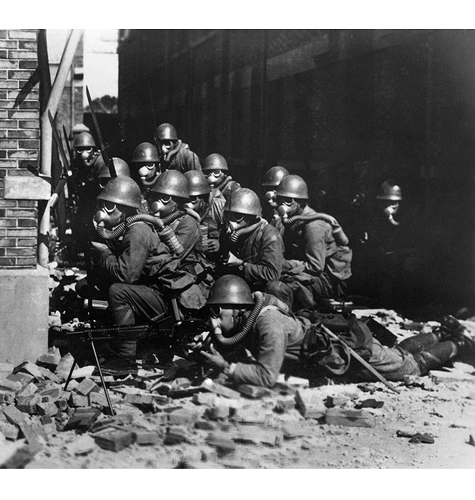The curious behavior of the rescuers do understand that they knew what to handle, perhaps of the carbon oxychloride “trivial” poison gas type (the Phosgene). This, above all is deadly, as it has a smell like hay, is completely colorless and kills you after a short exposure even after two days, if the concentration is low.
Rescuers without gloves and spraying water whitish on the bodies and everything around, just to suggest Phosgene
To decontaminate the affected area and the victims, and to be able to handle without problems it is sufficient to wash it all with water containing a basic solution, sodium carbonate type to 5%. Curious that rescuers they had the ready tanks.
Phosgene is the chemical compound with the formula COCl2. This colorless gas gained infamy as a chemical weapon during World War I where it was responsible for about 85% of the 100,000 deaths caused by chemical weapons. It is also a valued industrial reagent and building block in synthesis of pharmaceuticals and other organic compounds. In low concentrations, its odor resembles freshly cut hay or grass. In addition to its industrial production, small amounts occur from the breakdown and the combustion of organochlorine compounds, such as those used in refrigeration systems.
The chemical was named by combining the Greek words “phos” (meaning light) and “genesis” (birth); it does not mean it contains any phosphorus (cf. phosphine).
Safety
Phosgene is an insidious poison as the odor may not be noticed and symptoms may be slow to appear. The odor detection threshold for phosgene is 0.4 ppm, four times the threshold limit value. Its high toxicity arises from the action of the phosgene on the proteins in the pulmonary alveoli, the site of gas exchange: their damage disrupts the blood–air barrier, causing suffocation. It reacts with the amines of the proteins, causing crosslinking by formation of urea-like linkages, in accord with the reactions discussed above. Phosgene detection badges are worn by those at risk of exposure.
Sodium bicarbonate may be used to neutralise liquid spills of phosgene. Gaseous spills may be mitigated with ammonia.
Pubblicazione gratuita di libera circolazione. Gli Autori non sono soggetti a compensi per le loro opere. Se per errore qualche testo o immagine fosse pubblicato in via inappropriata chiediamo agli Autori di segnalarci il fatto è provvederemo alla sua cancellazione dal sito









